Cyclist Cory Ostertag finished runner-up in his first ever ultra bikepacking race, the BC Epic - a 1,000km self-supported route across southern British Columbia in Canada. The experience in 2021 motivated him to return better prepared the following year and he duly won the 2022 edition, before setting a new FKT for the 800km Log Driver's Waltz.
So, who better to ask about how to carry your fuel, hydration and essentials during a bikepacking adventure? We'll leave it to Cory to share his wisdom...
Riding bikes has always been a big part of my life. It started with seeing Hans Rey, Steve Peat, Missy Giove in the pages of Mountain Bike Action. Later it was all about Lance Armstrong and Alberto Contador at the tour.
However, growing up in a small town, there wasn’t an obvious development pathway for youngsters interested in cycling. It was a child’s pastime, not a serious sporting endeavour like soccer or hockey, so my parents didn’t really know how to support me in it.
When I was in university, I saved up for my first road bike, then I started racing a few years later. I climbed the ranks and raced in Cat 2, which is really just made up of gifted juniors, wannabe pros, and talented beer leaguers.
In training for road racing, I always enjoyed longer endurance rides with a bit of adventure mixed in. I loved the idea of point-to-point rides; using the bike to travel to a destination. After racing for a handful of years, I came to realise that I enjoyed the process of training and riding long distances more than racing itself, and so I started looking for other ways to enjoy cycling.
I dabbled in randonneuring and then became fascinated with ultra races like the TransAm, Trans Continental and the Tour Divide. I watched Mike Dion’s Ride the Divide and Inspired to Ride and these films really struck a chord with me.
Then the pandemic hit. Races were cancelled and solo adventuring became the new normal for a lot of bike racers, including myself…
First steps into bikepack racing
In 2020, I was preparing to ride the BC Epic, but of course it was cancelled due to the pandemic. By the time Lennard (the route master of the BC Epic) announced that the 2021 grand départ was a go, I was fully committed and absolutely nothing was going to stop me from starting or finishing that race.
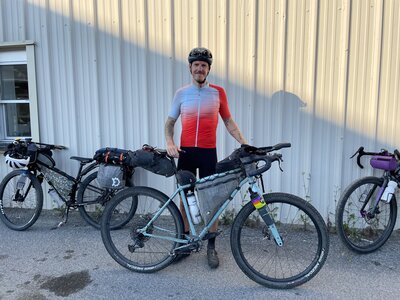
It was my first event and I finished second behind a very experienced ultra racer in brutally hot conditions. In hindsight, coming second was the best thing that could have happened because it forced me to dissect everything I did wrong and motivated me to come back way more prepared.
In 2022, I returned to race the BC Epic and finished first. I also finished first at the Buckshot, another event by the same organiser as the BC Epic. In August, I travelled to Ottawa, Ontario, and did the Log Driver’s Waltz, a very challenging 800km route. I finished first again and also set the FKT - about five hours faster than the previous time.
How to carry your bikepacking essentials
It feels like I carry everything, and not much at the same time. My packing list keeps evolving as I gain more experience. Sometimes I leave things behind, and regret it. Sometimes I carry things that I never use.
I break my packing list down into:
- Clothing
- Food
- Sleep kit
- Repair kit
- Electronics
- Self-care
- Essentials
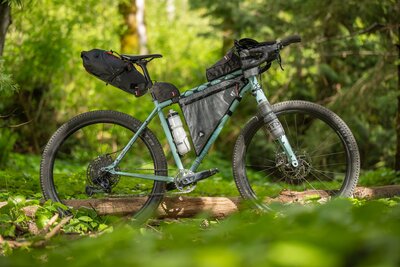
Clothing
For clothing I carry extra layers to protect me from the elements in case the weather changes, as well as some extra stuff to keep warm while sleeping and riding through the night. I always have a light GORE-TEX jacket (7mesh Oro), as well as packable down jacket (Mountain Hardware Ghost Whisperer) and some Icebreaker Merino baselayers.
The key with clothing is having some items that serve multiple functions. For example, I typically sleep in the down jacket in lieu of bringing a sleeping bag. Then when I wake up, I can just stay in the jacket and ride until I warm up.
Fuel
I probably start an event loaded up with more food than most people. Maybe about 8,000 calories. This is because a) I’m celiac and finding adequate gluten free food at gas stations can be challenging, and b) I try to avoid stopping. When others are making their first resupply stop, I can keep moving.
I quite like gels and I’ll start with enough to make most people cringe; some caffeinated and some not. I typically ration my PF 30 gels, keeping some accessible for day one, then another stash in my frame bag for days two and three. I also carry a variety of bars, dried figs and mango, some jerky and some extra PF 60 Drink Mix.
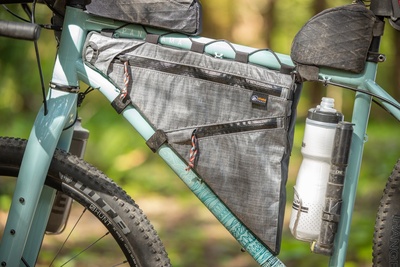
At gas stations, I’ll often pick up potato chips, corn chips as well as candy, a soda and those Starbucks Iced Frappucinos.
I start thinking about my hydration status during the days leading into an event, especially if I know temperatures are going to be high. I’ll start increasing the amount of fluids and maintaining my sodium levels with PH 500 tablets as I near an event.
I’ll always start a race with an entire tube of PH 1500 tablets and will almost certainly use them all. I would take more but then I’d be paying a weight penalty so I’ll supplement with the Electrolyte Capsules. I can’t stress how key these are to my whole hydration and fueling strategy. I’m consuming so much carbohydrate during these rides, much of it coming from ‘junk food’ from gas stations, that my stomach gets pretty volatile. The sodium enables my gut to absorb the nutrients from all the food and settles my stomach.
Sleep kit
My sleep kit is minimal and consists of an OR Helium Bivvy and a three-quarter length Thermarest Neoair sleeping pad.
Repair kit
My repair kit contains just about everything I need to do basic repairs, as well as some replacement parts like brake pads, chain quick links, tubeless valves and some extra tubeless sealant.
Electronics
For electronics, I will carry a SPOT tracker for emergency communications and GPS tracking which is typically required for events in order to validate results. I carry various charging cables, a cache battery, and some headphones.
I’m excited that for 2023 I’ll be running a dynamo hub to generate power and a Klite charging and light system so that I can keep the light running and everything charged while on the move.
Self-care (aka Hygiene)
This is really tricky in these events because I’m not showering and typically wear the same clothing for a few days in a row. I’ll try to clean myself with wet wipes and brush my teeth once a day. Skipping tooth brushing isn’t recommended because your mouth gets really thrashed and irritated from constantly eating. A good mouth cleaning is surprisingly satisfying in the middle of an ultra-event.
I also pack some chamois cream, my inhaler, sunscreen, lip balm, toilet paper and some pain killers. You have to be careful with the latter. Even Advil can hit you pretty hard when you’re dehydrated, malnourished and fatigued. I’ve had some crazy experiences with hallucinations thanks to Advil.
Bikepacking racing strategies
In off-road events I’m typically doing about 400km a day. The most I’ve ridden without sleep or a substantial rest was during the 2022 BC Epic where I rode 760km in 42 hours before stopping for a substantial break.
My general guideline is five minutes of stoppage time for every one hour of riding.
The exact allocation of break time will be dependent on the situation and the availability of resupply points. In some cases, I’ll push 10 hours with a handful of micro breaks and then stop for a longer rest and meal. In other events, I might do six hours non-stop and then take a 30-minute lunch.
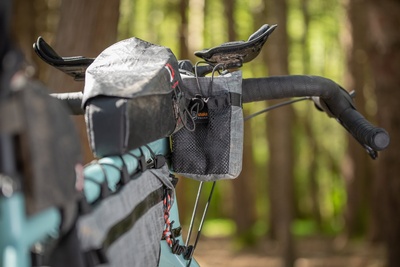
As the race goes on and you get more fatigued, it becomes harder to be diligent with that 60-minute to 5-minute on/off ratio, but I’ve taught myself to be efficient at rest stops and it’s something that I incorporate into my training.
When it comes to fueling, I don’t get hung up on calorie counting or macros. I’ll inevitably enter into a major calorie deficit after a 400km day, so it’s more important to just follow your cravings and eat what your gut can handle.
One rule that I do try to adhere to is to balance about one litre of water to 40-60 grams of carbohydrate per hour. In practice this is pretty easy to follow as most energy bars have roughly 30-40g of carbs and I’ll typically consume another 20-30g in my water. So, if I eat one bar per hour, then I would expect to also consume one full litre of water.
I do find that loosely following this guideline keeps my gut happy and allows me to continue getting food down. The PF 30 Gels and those huge PF&H Litre bottles certainly help simplify the math!
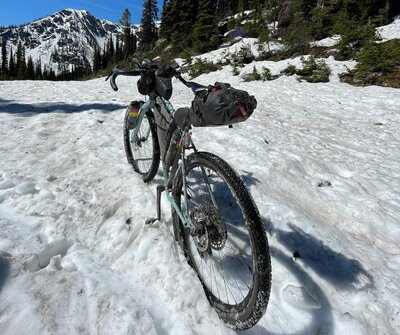
I always start an event with one serving of ‘real’ food packed away, typically a subway sandwich so that I can skip a lunch stop, then I generally rotate through a selection of sweet and savoury packaged items. I’ll attempt to source another meal at a resupply point so that I’m having a couple of solid meals a day. That said, when I rode the Log Drivers Waltz, I really struggled to find decent food and my timing with resupply points was off so I did the whole route entirely powered by gels, bars and gas station junk food.
A prepared meal at a sit-down restaurant would be amazing and I’ll totally do that if I’m touring, but during a race I’m always in a time crunch, so I look for fast food. Subway or A&W are my go-to places because they are fast and accommodate my dietary restrictions (vegetarian and gluten free). Regardless, I’ll always order something to eat right then and there, and something extra to pack away. I’ll toss a bag of fries into my feedbag and snack on those while I ride.
Lessons for a first-time bikepacker
I remember the first time I rode 300km, I was doing a brevet with a much more experienced rider. I was really worried about bonking and was eating continuously. It wasn’t hot, but humid in that cool and overcast pacific northwest kinda way. I didn’t really appreciate how much I was sweating. I also wasn’t supplementing my water with any sort of electrolyte or sodium.
By 200km I started to bonk badly. I was dizzy and my stomach was upset. I was confused because I thought I was doing everything right by taking in lots of food. I hadn’t considered that without electrolytes, much of the nutrients from food consumed goes wasted and just sits like a rock in your stomach. The guy I was riding with gave me a couple spare sodium tablets and I rebounded almost instantly.
My advice for a first-timer would be to remember that, if you reduce bikepacking to its simplest sense, it’s really just riding from point A to point B, sleeping, then doing it again the next day. Don’t overcomplicate it your first time; it doesn’t need to be epic.
My first trip on a bike was done with only a half frame bag I borrowed and packed with a pair of flipflops, gym shorts and t-shirt. A friend and I rode from Vancouver to Seattle, went out for pizza then crashed in a cheap motel, woke up and rode home. It was so much fun and we didn’t buy any special equipment to make it happen.
In 2022 I did three bikepacking races in the span of about three months in the summer. To be honest, it was too much. I would just be recovering then launching into a build phase for the next race. I didn’t have any downtime to relax or just bike for fun, so my advice would be don't overreach with your goals.
